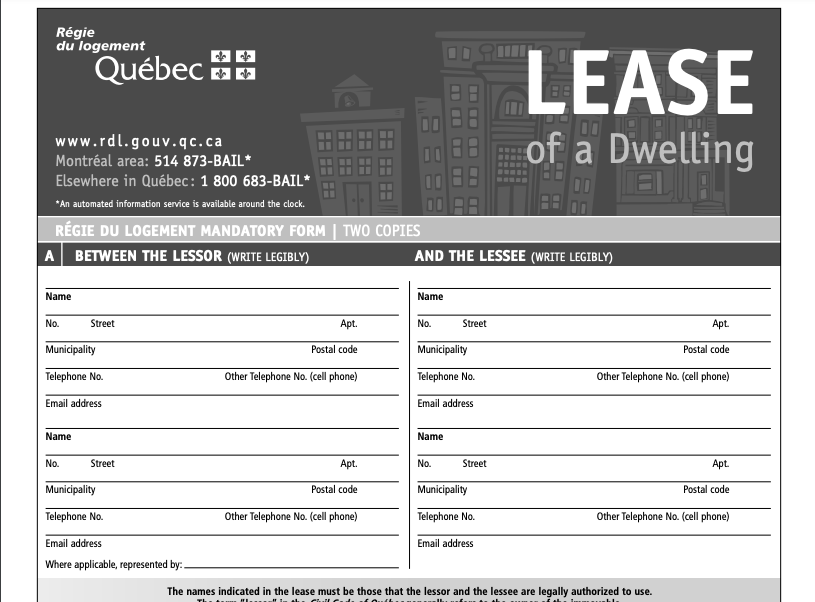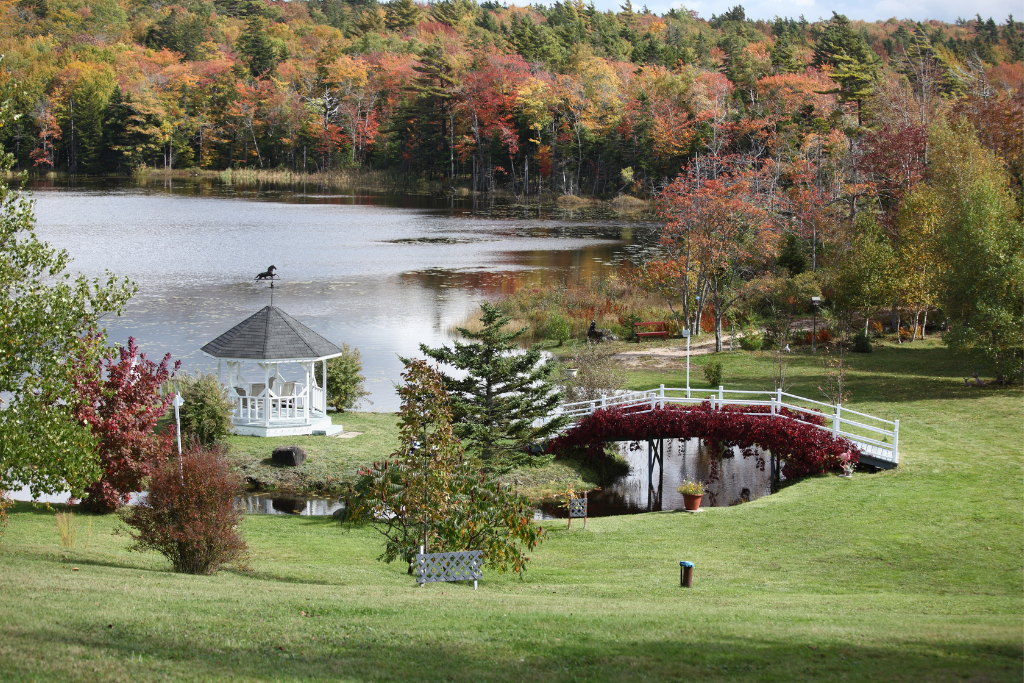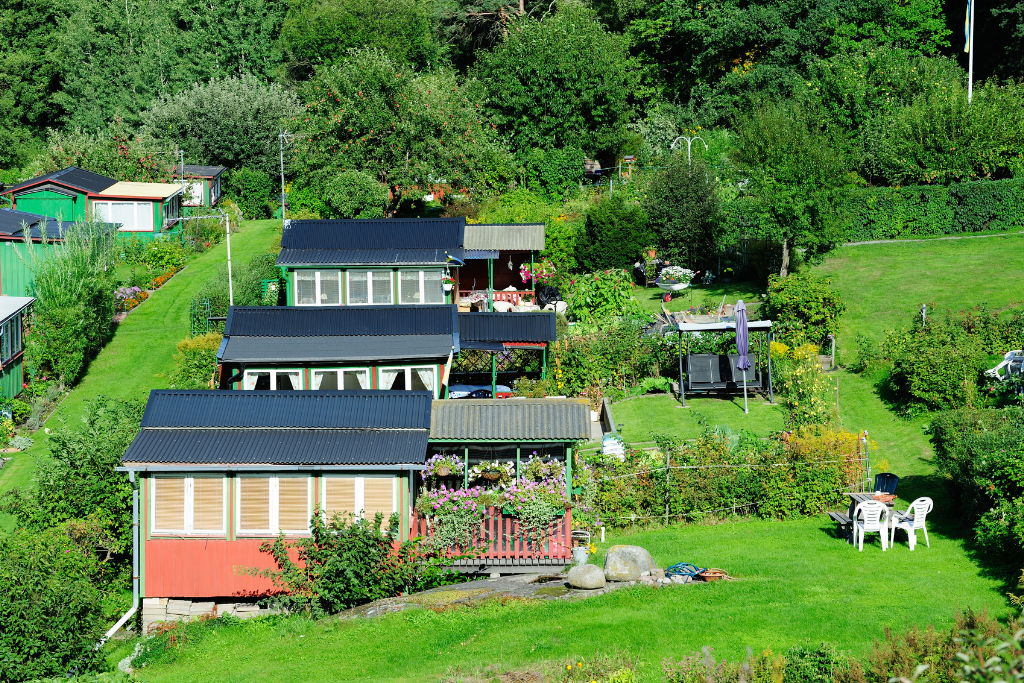Ontario’s Standard Form of Lease (Standard Lease)
The Standard Lease in Ontario is required for most residential tenancy agreements signed on or after March 1, 2021. It is mandatory for rental units but not for most social and supportive housing.

Important information about Ontario’s Standard Form of Lease
There are a few things to note about Ontario’s Standard Form of Lease. The standard lease must contain the following;
- Names of the people in the agreement, which are the names of the tenant(s) and landlord(s).
- A description of the rental unit, the address, and information on parking spaces if available. If the unit is part of a condominium, it’ll be indicated along with the rules of the condominium.
- Contact Information of the landlord(s).
- The terms of the agreement. This will indicate the date the tenant can move in and how long the lease will last. It will also indicate how long the agreement is for, i.e. weekly tenancy, monthly tenancy, or daily tenancy.
- The total rent (lawful rent), information on separate charges, when the rent is due, who it will be paid to, the method of payment, late fee policy, fees for returned cheques, and information on whether or not there will be a future rent increase.
- It will contain the list of services and utilities available as well as who is responsible for paying for the utilities.
- If there is a rent discount and how long the discount will last.
- If there is a rent deposit and how much it will be.
- If there is a key deposit, it should be mentioned
- The rules on smoking in the rental unit should be mentioned; however, smoking in common areas is not allowed under Ontario’s provincial law.
- If the landlord requires tenant’s insurance, it should be signified.
- If changes to the rental unit are permitted, it should be noted.
- The lease should state who is responsible for maintenance and repairs as well as the rules guarding this.
- The requirements for subletting the rental unit.
- Additional terms and conditions (i.e. pets and roommates).
- Any changes done to the lease must be done in writing.
- The signatures of the parties involved.
The Québec Régie du Logement Mandatory Form
All leases in Quebec have to use the standard lease form made available by the government, the Quebec Régie du Logement Mandatory Form – Lease of a Dwelling. The lease agreement is mandatory.

Important general information about the lease agreement in Quebec
- You’ll have to sign the lease before the move-in date.
- You’ll have to collect extra documents before you sign the lease.
- The lease should be written in French unless both parties agree to write it in a different language. All related paperwork thereafter should be written in the same language.
- You should receive one of the signed copies of the lease.
- Your landlord can ask to see your ID, but they are not allowed to make a copy of it.
- In Quebec, landlords are not allowed to ask for a deposit for damages.
- The lease may contain pet restrictions.
The lease may include non-smoking clauses. Quebec allows landlords to include the Prohibition against smoking cannabis in a dwelling clause in the lease.
Important information when filling out the Lease of a Dwelling Form
The lease form comes with Quebec’s rental laws so that the landlord and the tenant have an authentic source to reference while filing the form and signing the lease. The Quebec Régie du Logement Mandatory Form contains the following;
- Names and contact information of the tenant(s) and landlord(s).
- A description of the rental unit, the address, and information on parking spaces if available. If the unit is part of a condominium, it’ll be indicated along with the rules of the condominium.
- The duration of the lease.
- The total rent (lawful rent), information on separate charges, when the rent is due, who it will be paid to, the method of payment, late fee policy, fees for returned cheques, and information on whether or not there will be a future rent increase.
- It will contain the list of services and utilities available as well as who is responsible for paying for the utilities.
- Statements dictating how changes can be made to the rental agreement.
- The signatures of the parties involved.
The British Columbia Tenancy Agreement Regulations
British Columbia’s Tenancy Agreement Form is not mandatory; however, landlords are otherwise encouraged to prepare a written contract. Once a tenant pays the security deposit, the tenancy begins. The landlord must give the tenant(s) a printed copy within 21 days of signing the lease.
Not having a tenancy agreement form means tenants can’t access protections under the Residential Tenancy Act. It’s recommended to have one, with both landlord(s) and tenant(s) keeping individual copies.

Important information about The Residential Tenancy Agreement Form in British Columbia
The Residential Tenancy Agreement Form in British Columbia must include the following:
- Names of the people in the agreement, which are the names of the tenant(s) and landlord(s).
- The duration of the lease.
- The total rent (lawful rent), information on separate charges, when the rent is due, who it will be paid to, the method of payment, late fee policy, fees for returned cheques, and information on whether or not there will be a future rent increase.
- Information on which deposits are required. For each rental unit in British Columbia, a landlord can only request one security deposit and one pet damage deposit regardless of how many pets the tenants own. These deposits must not be more than half of a month’s rent. Landlords of manufactured home parks cannot request deposits.
- The residential tenancy agreement form should mention any pet restrictions.
- It will contain who is responsible for repairs.
- It will also contain the requirements for subletting the rental unit.
The Alberta Residential Tenancy Agreement Legislation & Types
The Alberta Residential Tenancy Agreement is protected by the Residential Tenancies Act. This Act applied to tenants who are residing in a rooming or boarding house (in most cases), a hotel/motel room rented out for more than 6 months at a time, a mobile home, a duplex, a house, and an apartment.
Before moving into a rental unit, the tenant(s) and the landlord(s) need to agree on the terms of tenancy and then sign the lease. This lease is the renter’s contract or the renter’s agreement to the terms set in the tenancy lease.

The Residential Tenancy Agreement is a mandatory agreement, written or verbal, can either be a periodic tenancy or a fixed-term tenancy. Periodic tenancies can be daily, weekly, monthly, or yearly with no end date, only a start date. They auto-renew unless terminated by tenant or landlord. Fixed-term tenancies have clear start and end dates and can be any length. No termination notice is needed if the tenant moves out at the end. Renewal requires landlord and tenant agreement.
The Residential Tenancy Agreement Form should contain all necessary information about the rental unit and terms. It should also contain information on the security deposit. The security deposit or the damage deposit is an amount a landlord collects as a sort of insurance in case of damages or if the tenant is unable to pay rent which is why it is also called the last month’s rent. A security deposit cannot be more than a month’s rent at the original time of rental. The security deposit must remain the same as it was when the tenancy started, even if and when the rent increases. Landlords are also required to deposit the damage deposit into an interest-bearing trust account in Alberta within two banking days of collection.
The Manitoba Residential Tenancy Agreement
The Manitoba Residential Tenancy Agreement Forms apply to several rental situations. In the agreement you can find a standard residential tenancy agreement form, one for subletting, one for mobile homes and sites, a rental unit condition report form, a notice to new tenant form, and a notice to new tenant form where the tenancy includes tenant services. The Manitoba Residential Tenancy Agreement Forms are mandatory in the aforementioned situations.

The Tenancy Agreement form or the Renter’s Contract/Renter’s Agreement in Manitoba should contain the following:
- It should contain information on the co-signers and guarantors.
- It should contain information on the sort of payments not permitted under the Residential Tenancies Act.
- It should contain rules specific to the landlord.
- It should contain the landlord’s stance on smoking, whether it is allowed in private or not allowed at all.
- It should contain information on the terms for renewal as well as if the tenancy is fixed-term or periodic and how long it will last.
- It should also contain general information such as contact details, names, etc.
Security deposit regulations for leases in Manitoba
The security deposit must not be more than half of a month’s rent, and the landlord should present the tenant with a receipt after collection.
Important information to understand in a written tenancy agreement in Manitoba
- Names of the people in the agreement.
- Contact Information of the landlord(s).
- The terms of the agreement. This will indicate the date the tenant can move in and how long the lease will last. It will also indicate how long the agreement is for.
- The total rent (lawful rent), information on separate charges, when the rent is due, who it will be paid to, the method of payment, late fee policy, fees for returned cheques, and information on whether or not there will be a future rent increase.
- It will contain the list of utilities available as well as who is responsible for paying for the utilities.
The Saskatchewan Residential Tenancy Agreement
Saskatchewan’s Residential Tenancy Agreement is protected by the 2006 Residential Tenancies Act. The Standard Conditions are to be included in every written tenancy agreement, and if there is anything contrary to what is present in the Standard Conditions, it is immediately overridden.
Landlords can choose any of the three tenancy types available under the act. This can either be a month-to-month tenancy, a tenancy that automatically renews each month, a weekly tenancy, a tenancy that automatically renews each week and a fixed-term agreement, a tenancy that has a fixed start date and a fixed end date.

What to include in a rental agreement in Saskatchewan
The landlord must give the tenant a copy of the Standard of Conditions. There is no government-issued form; however, written agreements must include the following;
- A copy of the Standard Conditions.
- Names of the people in the agreement.
- Service address, emergency contact information, and telephone number of the agent or landlord.
- Contact Information of the landlord(s).
- The terms of the agreement. This will indicate the date the tenant can move in and how long the lease will last. It will also indicate how long the agreement is for.
- The total rent (lawful rent), information on separate charges, when the rent is due, who it will be paid to, the method of payment, late fee policy, fees for returned cheques, and information on whether or not there will be a future rent increase.
- The exact amount of the rent and the difference between the tenant’s rent and the other tenants in the building.
- It will contain the list of services and utilities available as well as who is responsible for paying for the utilities.
- Reasonable rules of the landlord (i.e. smoking).
The Nova Scotia Standard Form of Lease (Form P)
The Nova Scotia Standard Form of Lease is also called Form P. The use of Form P is not mandatory; however, the conditions in Form P will always apply regardless of whether the form was used or not. Form P is a residential lease containing all necessary conditions that apply in a residential lease.
Important information to fill out and to know about Nova Scotia’s Form P
To use Nova Scotia’s Standard Form of Lease, the following information is needed:
- The full name of the tenant and if there are any adults or children set to live in the rental unit, their names must be included as well.
- The phone numbers of the tenant or tenants to ensure an easy mode of communication between the landlord and the tenant.
- The email address of the tenant.
- The emergency contact for the tenant. This can be the number of a family member.
- The terms of the agreement. This will indicate the date the tenant can move in and how long the lease will last. It will also indicate how long the agreement is for.
- It should state the amount of the rent.
- If there are utilities, services(parking, cleaning) and appliances included in the rent, it should be noted.
- The responsibilities of the tenant. If the tenant is responsible for maintenance or repairs, it should be stated. If the tenant is not responsible, the contact information of who will repair and maintain the rental unit should be included.
- The amount of the security deposit. The security deposit or the damage deposit should not be more than half a month’s rent. The landlord is required to deposit the damage deposit into an interest-bearing trust account in Nova Scotia within two banking days of collection.
- The landlord may also include their rules for smoking as well as a rental unit condition report.
The landlord and tenant are allowed to use this form. Once the form is completed and the lease is signed, the landlord is required to provide the tenant with a signed copy of the lease within 10 days of the lease being signed.
The New Brunswick Residential Lease Standard Form of Lease (Form 6)
The New Brunswick Residential Lease Standard Form of Lease or Form 6 is not mandatory; however, the Residential Tenancies Tribunal strongly recommends one. A Residential Lease Agreement, like a renter’s contract in Canada, is the written agreement between tenants and landlords, each needing an original signed copy, although the Tribunal doesn’t require a copy sent to their branch.
Landlords can include reasonable rules and obligations before lease signing, but any contradicting the Residential Tenancies Act are overridden. The lease remains valid if the building is sold. Leases end at midnight and can be periodic (monthly, weekly, or yearly) or fixed-term with set start and end dates.
Requirements in The New Brunswick Residential Lease Agreement Form
The New Brunswick Residential Lease Agreement Form requires the following;
- The name, contact information, and address of the tenant(s) and the landlord(s).
- The address of the rental unit, the type of the rental unit, permitted use, and reasonable rules (pets, smoking)
- The length of tenancy, the type of tenancy, and the date the tenancy expires.
- The amount and timing of payment, the payable amount of rent per week and month, the method of payment, and if the landlord will increase rent.
- Information on late payment fees.
- Information on services, utilities, furnishings, and if the rent includes these things.
- Information on the security deposit which should, in most cases, not be more than a month’s rent.
- Information on assignment, subletting.
- The signatures of parties involved.
The Newfoundland and Labrador Standard Rental Agreement Form
The Newfoundland and Labrador Standard Rental Agreement Form is required under Section 7 of the Residential Tenancies Act 2018.

In Newfoundland and Labrador, every rental agreement form is required to have the following information.
- The full and correct names of the landlord(s) and tenant(s).
- The telephone number, electronic address(i.e. email) and address of the landlord where documents may be received, delivered or served by the tenant.
- If the landlord is not available, then the telephone number, electronic address and civic address of the landlord’s agent where documents may be received, delivered or
- served by the tenant.
- The telephone and electronic address of the tenant where documents may be received, delivered or served by the landlord.
- The address of the rental unit.
- The date the rental agreement was signed.
- The date the tenancy begins.
- A specification on the type of rental agreement between the parties:
- Periodic tenancy (automatically renews until a quit notice is served).
- Week to week tenancy
- Month to month tenancy
- Fixed-term (with a clearly defined start and end date).
- The end date of a fixed term tenancy.
- The amount of rent that can be paid for a specified duration.
- The day (i.e. week, month) on which rent is due.
- The terms and conditions guiding the availability of services, furnishings and other equipment or facilities already included in the lease.
- The amount of any security deposit paid which should not be more than half a month’s rent.
- The date on which the security deposit was collected.
*The landlord is required to provide the tenant(s) with a copy of the signed written lease and the Residential Tenancies Act.
FAQ – Frequently Asked Questions About Lease and Rental Agreements in Canada
What is the difference between a lease and a rental agreement?
A lease is often a long-term contract between a landlord(s) and tenant(s) where the landlord leases a rental unit to the tenant for a specified amount of time (usually 12 months and over). A rental agreement, on the other hand, is a short-term contract. It usually lasts around 30 days and automatically renews after thirty days unless there’s a lease termination notice by the landlord or tenant.
What is a verbal lease agreement?
A verbal lease agreement is an oral contract. This is a legally binding contract between the tenant(s) and the landlord(s). It is made up of conversations on how much the rent is, when it is due, and other conversations concerning the rental process. Although verbal lease agreements are easy and straightforward, they have many drawbacks. Verbal lease agreements can easily be manipulated by one of the involved parties because there is no written document to reference. The terms may become unclear and the details blurry because there is no hard copy to refer to in the case of a misunderstanding. Therefore while a verbal lease agreement is legally binding in all provinces, it is strongly advised that you opt for written lease agreements and specify so on your rental application form.
How do I proceed to terminate a lease early?
To terminate a lease early, you’ll first need to know the type of lease you have. There are two types of leases- a fixed-term and a periodic term lease. A fixed term is a tenancy that is set for a specific amount of time, while a periodic term has no set end date.
If you have a fixed-term tenancy, here is the most common way to proceed (may vary by province). You can talk to your landlord and consider subletting your rental unit or assigning it to someone else. You can also mail or give your landlord a notice that indicates you want to terminate your lease early. The required time frame for notices tends to differ from state to state; however, it is usually 60 days.
If you have a periodic tenancy, you should note if it’s a daily, weekly, or monthly tenancy. These types of leases are easier to get out of because of the short time frame. The required time frame for periodic tenancy notices is 28 days for weekly and daily tenancies and 60 days for a monthly tenancy.
Can a landlord refuse to renew a lease?
In Ontario, landlords can refuse to renew a lease for the following reasons: If the landlord or the landlord’s immediate family member has to move into the rental unit, the landlord has to perform a major renovation, the tenant doesn’t pay rent, damages the unit, disturbs other tenants, or commits an illegal act, the landlord wants to demolish the property or the tenant sublet the apartment to an unauthorized occupant.
In Quebec, leases are automatically renewed and so landlords can only refuse to renew a lease if they or an immediate family member has to move into the rental unit. The landlord must inform the tenant 6 months in advance for fixed-term leases and 1 month in advance for leases of 6 months or less.
In British Columbia, landlords can refuse to renew a lease if the tenant isn’t paying rent, for personal use of property, for a major renovation, for conversion of manufactured home park, and if the tenant doesn’t qualify for subsidized housing.
In Alberta, landlords can refuse to renew a lease if the agreement was breached and for prescribed reasons.
In Manitoba, landlords can refuse to renew a lease for any of the reasons laid out in the local legislation.
In Saskatchewan, landlords can refuse to renew a lease for any of the prescribed reasons in the local legislation.
In Nova Scotia, tenants with periodic term leases cannot have their lease terminated unless the landlord has a valid reason.
In New Brunswick, landlords can refuse to renew a lease if they want to use the unit personally, renovate, or use the unit for another purpose that is not residential.
In Newfoundland and Labrador, landlords can refuse to renew a lease if the rent is 15 days late, the unit is abandoned/uninhabited, a material breach has occurred, or the tenant interferes with the peaceful enjoyment of other tenants.
Conclusion
It is important to always take note of the standard form of lease used in your province. Although there are similarities, there are a few differences to always take note of. We hope that this article has been informative, helpful and provided you with a definitive guide to understanding lease and rental agreements in Canada. Thinking of renting a home? Here’s what to consider before renting a home.





